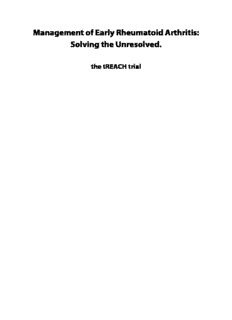
Management of Early Rheumatoid Arthritis PDF
Preview Management of Early Rheumatoid Arthritis
Management of Early Rheumatoid Arthritis: Solving the Unresolved. the tREACH trial Financial support for the publication of this thesis was kindly provided by: Pfizer B.V., AbbVie B.V., Dutch Arthritis Foundation and Masters in Business B.V. ISBN: 978-90-5335-734-7 Cover design by Ridderprint B.V., J. Bakker, P.H.P. de Jong. Design and lay-out of thesis by Ridderprint B.V., P.H.P. de Jong. Printed by Ridderprint B.V. No part of this thesis may be reproduced or transmitted in any form or by any means without prior permission of the author, P.H.P. de Jong, or when appropriate, of the scientific journal in which parts of this thesis have been published. © 2013 P.H.P. de Jong Management of Early Rheumatoid Arthritis: Solving the Unresolved. the tREACH trial Behandeling van vroege reumatoïde artritis: Het onopgeloste opgelost het tREACH onderzoek Proefschrift ter verkrijging van de graad van doctor aan de Erasmus Universiteit Rotterdam op gezag van de rector magnificus Prof.dr. H.A.P. Pols en volgens besluit van het College voor Promoties. De openbare verdediging zal plaatsvinden op 10 december 2013 om 15:30 uur door Pascal Hendrik Pieter de Jong geboren te Rotterdam PROMOTIECOMMISSIE Promotor: Prof.dr. J.M.W. Hazes Overige leden: Prof.dr. J.L.C.M. van Saase Prof.dr. T. van Gelder Prof.dr. M. Boers Co-promotor: Dr. A.E.A.M. Weel Table of contents 9 CHAPTER 1 General introduction 21 CHAPTER 2 Ann Rheum Dis. 2013 Jan; 71 :72-8. Induction therapy with a combination of DMARDs is better than methotrexate monotherapy: first results of the tREACH trial. 43 CHAPTER 3 Submitted Initial triple DMARD therapy is more efficient than methotrexate monotherapy in recent onset rheumatoid arthritis; 1-year data of a randomized clinical trial (tREACH) 77 CHAPTER 4 Submitted Best cost-effectiveness and worker productivity with initial triple DMARD therapy compared with methotrexate monotherapy in early rheumatoid arthritis; Cost-utility analysis of the tREACH trial. 107 CHAPTER 5 Rheumatology (Oxford). 2012 Jul; 51: 1269-77. Treatment decisions and related costs differ significantly depending on the choice of a disease activity index in rheumatoid arthritis, according to 1987 and 2010 classification criteria. 127 CHAPTER 6 Ann Rheum Dis. 2013 Sep; 72: 1659-1663. Response to glucocorticoids at 2 weeks predicts the effectiveness of DMARD induction therapy at 3 months: post hoc analyses from the tREACH study. 143 CHAPTER 7 Arthritis Rheum. 2012 Oct; 64: 3095-101. Brief Report: To squeeze or not to squeeze, that is the question! Optimizing the disease activity score in 28 joints by adding the squeeze test of metatarsophalangeal joints in early rheumatoid arthritis. 155 CHAPTER 8 General discussion 169 CHAPTER 9 Summary 175 CHAPTER 10 Nederlandse samenvatting 181 ADDENDUM PhD portfolio Publications About the Author Acknowledgements Role of funding source Dankwoord CHAPTER 1 General introduction RHEUMATOID ARTHRITIS Rheumatoid arthritis (RA) is a systemic auto-immune disease, which is characterized by chronic inflammation of multiple joints. About 1% of the people in western countries have RA, and each year in 5 – 50 per 100.000 persons the diagnose of RA is made. The prevalence of RA varies geographically.1 In the Netherlands the prevalence of RA in 2007, based of primary care registries, was 0.7% (95% confidence interval (CI): 0.48% - 1.03%) for men and 1.1% (95% CI: 0.76% - 1.60%) for women. The mean annual incidence in the Netherlands in 2007 was respectively 75 and 120 per 100.000 for men and women. Disease onset is most often between 40 and 60 years of age. The mortality rate for men and women with RA in 2010 was respectively 0.3 and 0.9 per 100.000.2 Clinical and radiographic outcomes have improved enormously in the last two decades, due to major paradigm changes in the management of RA.3-4 Evolvement of clinical trial methodology, emergement of new therapeutic options – in particular biologicals – and reevaluating treatment strategies caused these major paradigm changes. These paradigm changes are: • Early detection of the disease; • Early initiation of ‘intensive’ therapy; • A treat-to-target approach The 2010 ACR/EULAR classification criteria for RA and formulation of the EULAR recommendations for the management of RA were developed, so rheumatologists could apply these changes in daily practice.3-4 The 2010 EULAR recommendations advocate, in patients with newly diagnosed RA, that: (1) the initial treatment strategy encompasses at least methotrexate (MTX) with or without glucocorticoids (GCs), (2) treatment is targeted to achieve remission, or low disease activity, preferably within 3 months, and (3) treatment should be adjusted, every 1-3 months, until the target is reached.4 Complying with these recommendations result in better functional and radiological outcomes.1, 5 Despite of the new classification criteria and treatment recommendations, important unresolved questions for daily practice remain. Therefore, the focus of this thesis will be on the management of early RA. In the next section I will elaborate on the argumentation for each paradigm change and accentuate the unresolved questions, which need to be solved for daily practice. Early detection of the disease Various studies suggest the existence of a ‘window of opportunity’, which encompasses the first 12 weeks after symptom onset. Early initiation of Disease Modifying Anti- Rheumatic Drugs (DMARDs) during this 12 week period improved clinical outcome and delayed or even prevented radiographic damage.6-11 Distinguishing RA from other arthritic disorders is rather difficult, especially in the very early stages of the disease. Until 2010 only the 1987 classification criteria for RA, made by the American College of
Description: